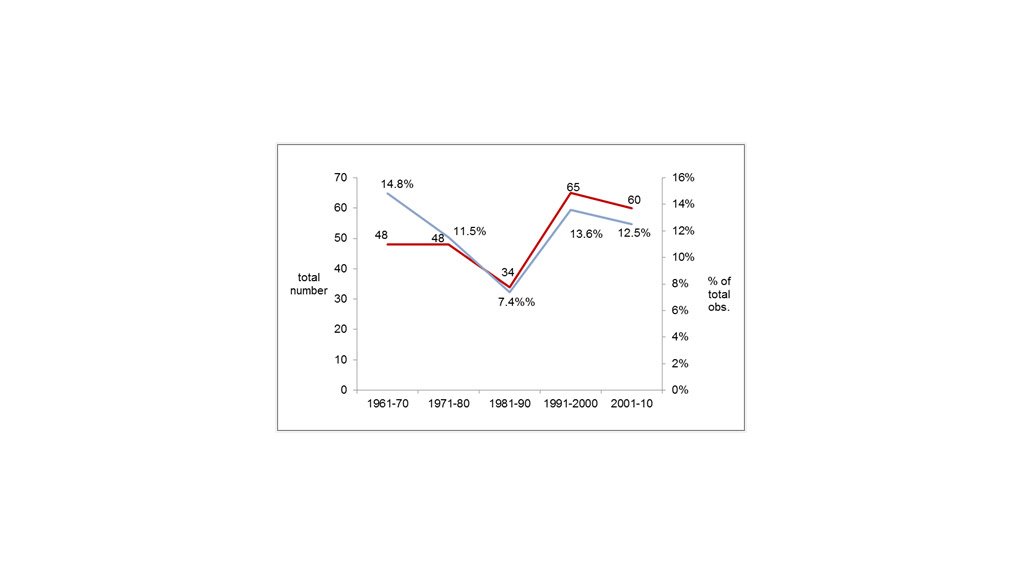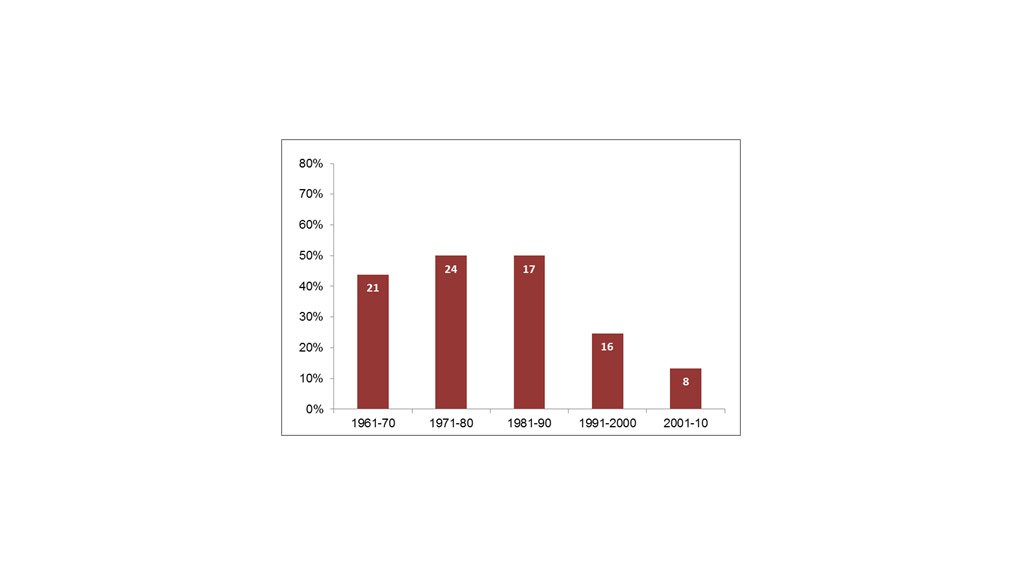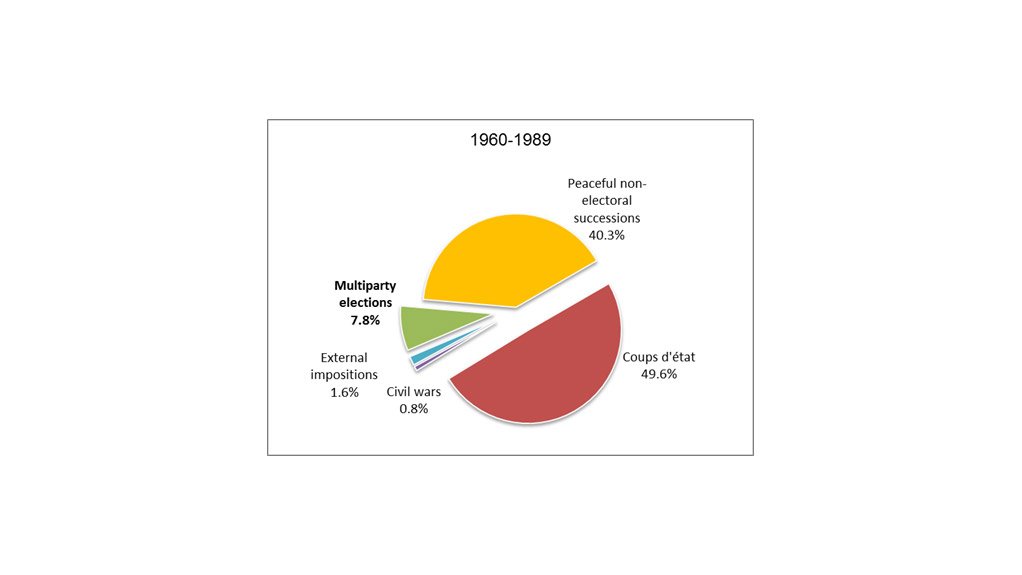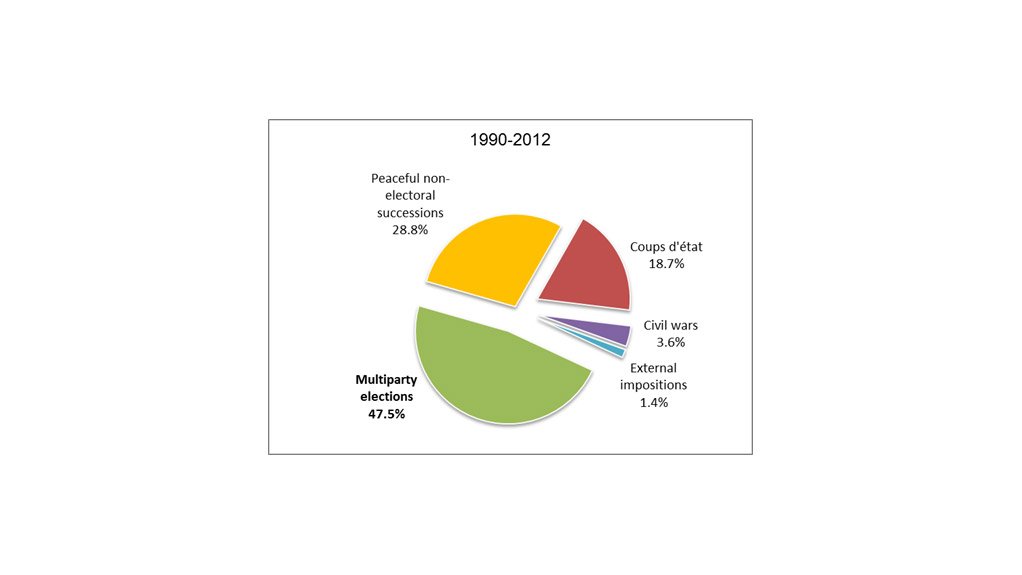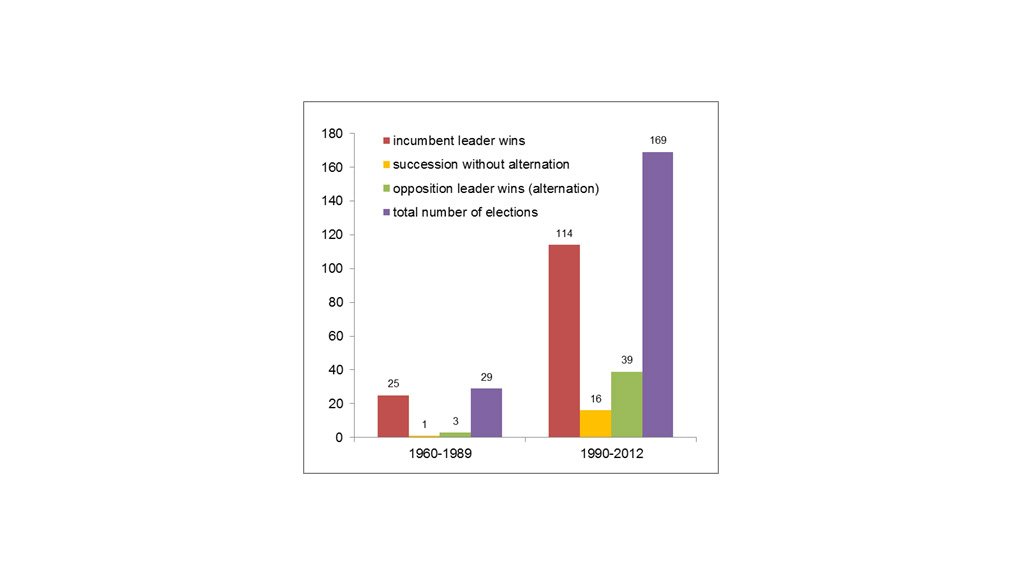In the 2012 Senegalese election, opposition leader Macky Sall defeated incumbent president Abdoulaye Wade and duly replaced him as the country’s new head of state. In that same year, vice-president Joyce Banda was swiftly sworn in as president of Malawi following the death of her predecessor, Bingu wa Mutharika, only two days earlier. In Mali, President Amadou Toumani Touré was ousted from power also in 2012, but this time via a coup d’état led by Captain Amadou Sanogo. These were very different ways in which power was handed over in three distinct countries in Sub-Saharan Africa (SSA): through an open and competitive election in Dakar, through a peaceful non-electoral succession in Lilongwe, and through a classic military golpe in Bamako.
This CAI paper investigates the impact of the spread of multiparty electoral politics in Africa, over the past two decades, on the way political leaders are recruited and replaced in SSA. It does so by using data from an original Leadership Change Dataset, compiled by the author, which covers all 49 Sub-Saharan countries from 1960 (or subsequent years of independence) to 2012.
Africa’s shift to multiparty elections
Typically ruled by single-party leaders or military autocrats, post-independence African countries have long been associated with various forms of repressive regimes. Either violence was used to reach power (as with military overthrow and guerrilla takeovers), or violence was important in holding on to it (as was the case not only where soldiers administered power, but also in many one-party states). Little room was left for peaceful handovers of power or for governments elected by the civilian population through a competitive vote. Much of this political set up appeared to change since the early 1990s, when a reform movement that led to the widespread introduction of multi-party elections shook most countries on the continent.
This was not only the time when the African National Congress (ANC) was elected to office in South Africa, but also when the likes of Kenneth Kaunda in Zambia, Daniel Arap Moi in Kenya and Jerry Rawlings in Ghana had to concede that their mandates would eventually be challenged in multi-candidate presidential elections.
From the outset, it was clear that the vote in this new wave of African elections would often be neither free nor fair. Powerful rulers such as Omar Bongo (Gabon), Paul Biya (Cameroon), Yoweri Museveni (Uganda) or Meles Zenawi (Kenya) proved that it was one thing for them to call a pluralist election, however, it was an entirely different matter to allow their political opponents a genuine and open opportunity for challenging them. A long list of African leaders thus managed to weather the electoral ‘revolution’ and stay in office, soon recovering most of the power they had given away (if any) during the transition. To date, as many as eight contemporary African rulers have been in power for 25 years or more and 5 of SSA’s 10 longest-serving leaders remain at the helm of their countries.
| Leader | In power from/to | Consecutive years in office |
|---|---|---|
| 1. Omar Bongo (Gabon) | 1967-2009 | 42 |
| 2. Gnassingbé Eyadéma (Togo) | 1967-2005 | 38 |
| 3. Josè Eduardo dos Santos (Angola) | 1979-2014 (in office) | 35 |
| 4. Teodoro Obiang Nguema Mbasogo (Equatorial Guinea) | 1979-2014 (in office) | 35 |
| 5. Robert Mugabe (Zimbabwe) | 1980-2014 (in office) | 34 |
| 6. Félix Houphouët-Boigny (Cote d'Ivoire) | 1960-1993 | 33 |
| 7. Haile Selassie I (Ethiopia) | 1941-1974 | 33 |
| 8. Paul Biya (Cameroon) | 1982-2014 (in office) | 32 |
| 9. Joseph-Désiré Mobutu (Congo, Dem. Rep.) | 1965-1997 | 32 |
| 10. Mswati III (Swaziland) | 1983-2014 (in office) | 31 |
| 11. Hastings Banda (Malawi) | 1964-1994 | 30 |
| 12. Dawda Jawara (Gambia) | 1965-1994 | 29 |
| 13.Yoweri Museveni (Uganda) | 1986-2014 (in office) | 28 |
| 14.Blaise Compaoré (Burkina Faso) | 1987-2014 (in office) | 27 |
| 15. William Tubman (Liberia) | 1944-1971 | 27 |
| 16. France-Albert René (Seychelles) | 1977-2004 | 27 |
| 17. Kenneth Kaunda (Zambia) | 1964-1991 | 27 |
| 18. Ahmed Sékou Touré (Guinea) | 1958-1984 | 26 |
| 19. Omar Al-Bashir (Sudan) | 1989-2014 (in office) | 25 |
Table: Longest-serving rulers in post-independence Sub-Saharan Africa (2)
Leadership changes in Sub-Saharan Africa
Do these findings mean that the adoption of formal multi-party elections actually change very little in the way Africa’s top political posts are allocated? No, quite the contrary. The practice of running multi-party presidential elections that was introduced about two decades ago did mark a true – if incomplete – watershed. A look at comprehensive data on the way that leaders came into power, and left power, in SSA since 1960 shows how the period after 1990 has been characterised by significantly different dynamics when compared to the previous one.(3)
First, the very occurrence of leadership changes – i.e. the replacement of a country’s top political leader – which had been declining in absolute as well as in relative terms (i.e. as a share of all observations, which in turn depends on the actual number of independent countries in any given year) between the 1960s and the 1980s, has gone up significantly since the 1990s. During the last decade of the millennium, the number of new leaders across the continent went up to 65, from a much lower 34 during the previous decade, almost doubling the percentage of country-years in which a leadership change took place (from 7.4% to 13.6%). The 2000s essentially confirmed this new trend. In other words, the diffusion of multi-party elections coincided with a period of more frequent political successions.
Secondly, coups d’état, which had become a common way of taking power since the 1960s and came to represent about 50% of all leadership changes during the subsequent two decades, were halved to 24.6% in the 1990s and halved again to 13.3% in the 2000s.(4) During the latter decade, only eight leaders ascended to their country’s top office through a military intervention, or between one third and one half of the number of putsches in every single one of the previous four decades.
Thirdly, multi-party elections overtook both military interventions as well as non-electoral peaceful handovers and became the predominant way to the presidency. As many as 47.5% of all leadership changes during the 1990-2012 period, i.e. after electoral practices began to be widely adopted in the region, occurred via elections. This was up from a mere 7.8% during 1960-1989. The vote thus replaced the gun as the primary means of getting to power. Military takeovers, which represented 49.6% of all leadership changes during Africa’s first three decades since independence, lost what legitimacy they had in the past and declined to 18.7% in 1990-2012.
Furthermore, peaceful transfers of power to non-elected officials also went down significantly, albeit they remain an option, particularly for transitional periods. Consider, for instance, that as many as nine presidents died in office between 2001-2012, including Togo’s ÉtienneEyadéma Gnassingbé in 2005, Guinea-Conakry’s Lansana Conté and Zambia’s Levy Mwanawasa in 2008, Nigeria’s Umaru Yar’Adua in 2010, and Ghana’s John Atta Mills in 2012. They all had to be temporarily replaced before a new election could take place.
Fig 1: Number and percentage of leadership changes, per decade (1961-2010) (5)
Fig 2: Coups d’état as a share of total leadership changes, by decade (1961-2010) (6)
Fig 3 A&B: Modes of leadership change, 1960-1989 vs. 1990-2012 (7)
Opposition victories and changes in power
While the use of the ballot box does tell us something about popular participation and formal political inclusion, the question remains as to what extent opposition candidates and parties have been allowed to truly challenge incumbent leaders (and possibly oust them) at election time. It is well known that, in many African countries, holding formally pluralist elections did not prevent incumbent presidents and their political allies from managing and controlling the process in such a way that, whether through co-optation, coercion or a combination of the two, they would ensure that they remained in power. So how often did it happen that opposition politicians were able not only to run but actually to win an election and get to power, as in the cases of John Kufuor in Ghana (2000), Mwai Kibaki in Kenya (2002) or Macky Sall in Senegal (2012)?
As shown in the graph below, the number of multi-party elections for the executive skyrocketed over the past two decades, up from an average of 0.97 elections per year (1960-1989) to 7.35 elections per year (1990-2012). In a number of cases, the polls were also instrumental in the handover of power between leaders belonging to the same ruling political party. These were instances of leadership succession without political alternation. Yet, during 1990-2012, the opposition was able to snatch a victory in as many as 39 cases (or 23.1%, i.e. between one-in-four and one-in-five elections), something that had occurred three times only (or 10.3%) during the previous thirty years.
Fig 4: Opposition victories and alternation in power via elections, 1960-1989 vs. 1990-2012 (8)
The impact of electoral progress on economic development
Political progress in Sub-Saharan Africa is incomplete and uneven. Countries such as Eritrea or Sudan remain deeply authoritarian, the likes of Uganda or Tanzania are only partly reformed, and others, such as Sierra Leone, Senegal or Namibia, have made important democratic advances. Moreover, the extent of corruption, still a major concern on the continent, also varies quite significantly. Yet electoral accountability and alternation in power have generally increased, which, in turn, has supported the economic development of Africa.
Several observers have noted that the economic performance of African countries has been positively affected by recent democratic gains.(9) Political reforms largely took place between 1990 and 1994. Economic progress became visible in the second half of the 1990s, and advanced particularly during the subsequent decade. While SSA states grew by an average 2.1% annual rate during the period between 1990 and 1999 (largely due to the higher rates in the second half of the decade), this figure more than doubled between the period 2000 and 2012, when countries in the region achieved a 4.7% growth average. Political change was allegedly a key factor.
Concluding remarks
Up until the 1990s, democratic rule had largely failed to take root in countries in SSA. Yet, since the 1990s, the region has become home to a large-scale movement of political reform that has led to the widespread adoption of multiparty elections. In spite of the many shortcomings of the reformed regimes, profound changes emerged in the way in which African leaders are selected, empowered and ultimately removed from office. Military coups d’état, once the main route to power, nowadays appear to be more a legacy of the past than a tolerated way to the top executive office.
Elections, on the contrary, have become a virtually inescapable mechanism for the legitimisation of new rulers. Moreover, as pluralist elections spread and leadership changes became a more frequent phenomenon than they used to be, post-1990 Africa’s opposition leaders have considerably improved their chances of ousting incumbent presidents through a competitive vote. Finally, recent democratic progress likely contributed to the impressive economic performance of the region in the new century.
Written by Giovanni Carbone (1)
NOTES:
(1) Giovanni Carbone is a Consultant with CAI and Associate Professor of Political Science in the Department of Social and Political Sciences of the Università degli Studi di Milano (Italy). Contact Giovanni through Consultancy Africa Intelligence's Elections and Democracy unit ( elections.democracy@consultancyafrica.com). Edited by Liezl Stretton. The author would like to thank Anita Bianchi for research assistance in building the Leadership Change Dataset.
(2) Compiled by the author using data from the Leadership Change Dataset, available from the author on request.
(3)While our Leadership Change Dataset also includes instances of ‘interim leaderships’ (i.e. African leaders in office for less than 12 consecutive months), we do not count them in the data presented in this paper.
(4) Compiled by the author using data from the Leadership Change Dataset, available from the author on request.
(5) Ibid.
(6) Ibid.
(7) Ibid.
(8) Ibid.
(9) For example, ‘The hopeful continent. Africa rising’, The Economist, 3 December 2011, http://www.economist.com; ‘Africa and the Arab Spring: A new era of democratic expectations’, Africa Center for Strategic Studies, Washington, D.C., November 2011, http://africacenter.org; Radelet, S., 2010. Emerging Africa: How 17 countries are leading the way. Center for Global Development: Washington, D.C.
EMAIL THIS ARTICLE SAVE THIS ARTICLE
To subscribe email subscriptions@creamermedia.co.za or click here
To advertise email advertising@creamermedia.co.za or click here









